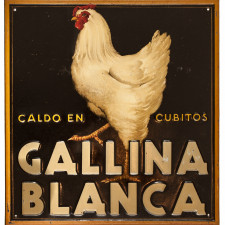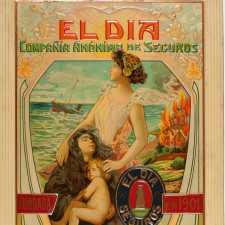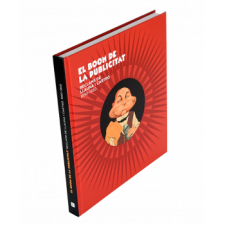The Advertising Boom. Tin, cardboard and tile posters. 1890-1950


Stand display. Artiach. La buena galleta. c. 1930. Col. Mateu Llinàs i Audet. Photo: Frederic Camallonga

Fábrica de Mayólica y Azulejos. Francisco Lahuerta. Ceramic panel, glazed and tubed, 1925-1936. Fábrica de Mayólica y Azulejos Francisco Lahuerta. Museu de Ceràmica de Manises.
The exhibition is a tour, from the end of the 19th century to the middle of the 20th, through graphic commercial advertising dedicated especially to the promotion of everyday products: food, wines and cavas, pharmaceuticals, care products, tobacco, machines etc.
Besides popular paper posters, the exhibition highlights how advertising adopted other media such as tin, cardboard and ceramic-tile posters. This led to a much broader distribution of the products advertised, particularly in shops, over counters, in shop windows and on façades.
Two-dimensional tin and cardboard posters and even large-format three-dimensional pieces in the case of cardboard, served as powerful advertisements at shop entrances, often with life-size figures that became popular icons of their day. The purpose was to promote the products’ qualities and advantages, by highlighting in particular the name of the manufacturer, which, in an effort to position itself in the market, began to use design to create an attractive brand image.
Chromolithographic printing (lithographs in colour), an innovative copying process at the time which helped to spread paper advertising posters, was also applied to tin and cardboard, filling the world of advertising with colour as it had already done with the world of publishing.
On the other hand, when it came to ceramic tiles, the most refined were produced from the ancient technique of tube-lining (using a separating clay cord of painted varnishes for differentiating decorative lines), recovered at the end of the 19th century and applied in particular to advertising panels, used on white boards achieving a high-quality relief. They were mainly made in Valencia.
A large part of the advertisements displayed were produced in Catalonia, apart from ceramic posters, most of which came from Valencia.
The exhibition presents over 250 items, created by artists and professional illustrators alike, often anonymous, and on loan from the Mateu Llinàs i Audet Collection from Barcelona and the Museu de Ceràmica de Manises (Valencia).
Its aim is to give everyone access to these advertisements, which were so popular in their day and now belong to the world of collecting and museums, having become considered as cultural heritage for their communicational, artistic and social aspects.
This is heritage that will evoke a distant past in the oldest and the not so old, and which will awaken the interest and admiration among the very young as they discover the strength of icons that have survived for around a century, by adapting to the times. Originally conceived as an ephemeral product, this heritage will undoubtedly provide plenty of inspiration for the next generations of professionals in the field.
Organised by: Museu del Disseny de Barcelona
Works from: Mateu Llinàs i Audet Collection, Museu de Ceràmica de Manises, Museu del Disseny de Barcelona
In collaboration with: Museu de Ceràmica de Manises and Museu de Badalona
Curator
Pilar Vélez
Dates
Space
B floor
Prices
General admission: €3
Reduced admission: €2



















